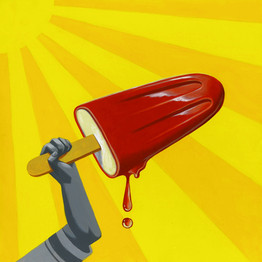WSJ Historically Speaking: When Summer Is a Bummer
Summertime has officially begun. But is it really true, as the George Gershwin song claims, that “the livin’ is easy”?
Benjamin Franklin advised his fellow Americans against seasonal complacency, observing, “Some are weather-wise, some are otherwise.” For many people, summertime means either the threat of floods and hurricanes or the pain of wildfires and droughts. Nothing easy there.
In Britain, however, summertime has always posed a somewhat different problem—more existential than experiential. As with invisible protons, being certain of the existence of the British summer requires a leap of faith. Lord Byron wasn’t convinced, writing, “The English winter—ending in July, to recommence in August.”
Some years have indeed been summerless, such as 1816, which came to be known as the “Year Without a Summer.” Two centuries ago, a series of volcanic eruptions began in Southeast Asia and culminated in the April 1815 explosion of Mount Tambora in Indonesia. On the “volcanic explosivity index,” a measure devised in 1982 by geologists Chris Newhall and Stephen Self, the eruption measured VEI-7. (The index’s highest level is 8.) The huge mass of smoke, sulfur and ash caused a kind of volcanic winter that had devastating effects on the world’s climate. Summer harvests along the eastern seaboard of the U.S. were ruined by snow and ice; parts of China were devastated by flooding; the Indian monsoon season was a bust; and incessant rain in Europe created hundreds of thousands of economic refugees. Famine, disease and death stalked the Earth.
On the upside, the high levels of tephra—volcanic ash and rock fragments—in the atmosphere caused the dramatic sunsets captured by the artist J.M.W. Turner. Mary Shelley’s “Frankenstein” came about because most of her vacation near Lake Geneva was spent indoors. Meanwhile, in America, the Latter Day Saint movement arose indirectly from the year’s blighted harvests in Vermont. The loss of their crops helped convince the family of Joseph Smith, the father of Mormonism, to move to New York, where he experienced the first of his prophetic visions. The rest, as the saying goes, is history.
It would be 150 years before another summer—the “Summer of Love” in 1967—would arguably have such a profound impact on cultural life. This time, it wasn’t so much the weather as copious amounts of drugs that provided the backdrop for such works of genius as Pink Floyd’s debut album “The Piper at the Gates of Dawn” and the Beatles’ immortal “Sgt. Pepper’s Lonely Hearts Club Band.” The Haight-Ashbury district in San Francisco became a beacon for 1960s counterculture and hirsute living. During the summer, more than 75,000 young people came to San Francisco to have their consciousness raised, wear flowers and “meet some gentle people there.” Other offshoots of the Summer of Love included the LSD advocate Timothy Leary (known to his admirers as “the Galileo of Consciousness”) and the Broadway musical “Hair”: all highlights or lowlights of the hippie era, depending on one’s point of view.
As summer arrives, it may be worth remembering the seminal study conducted in the 1970s on weather and violence. Two psychologists, R.A. Baron and V.M. Ransberger, looked at 102 U.S. riots between 1967 and 1971 and found that civil violence reaches a crescendo as the temperature rises into the mid-80s. In other words, an ambient 80 degrees Fahrenheit seems to make ideal conditions for a riot.
The largest study to date on the issue, by the economists William Collins and Robert Margo in 2005, reaffirmed what may seem a little obvious. From the July 1863 New York City draft riots to the July-August 1919 Chicago race riot to the August 1965 Watts riots in Los Angeles, there appears to be a pattern: Summer is to riots what winter is to influenza. Any officer of the law will affirm the old aphorism: “Rain is the best policeman.”

